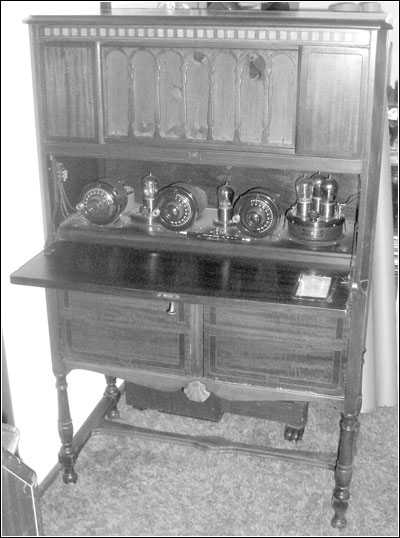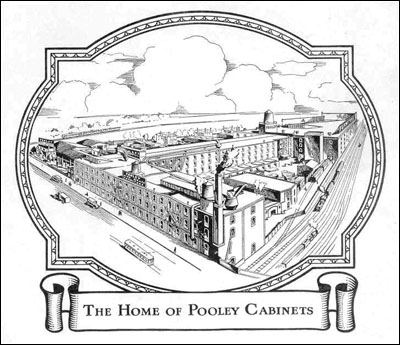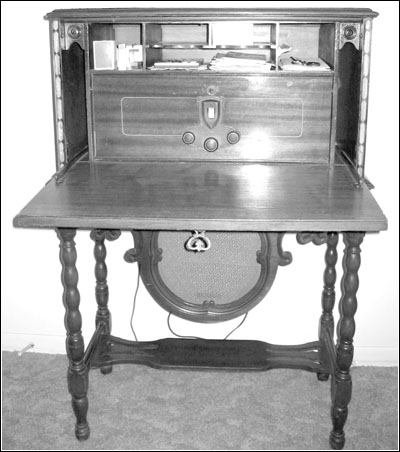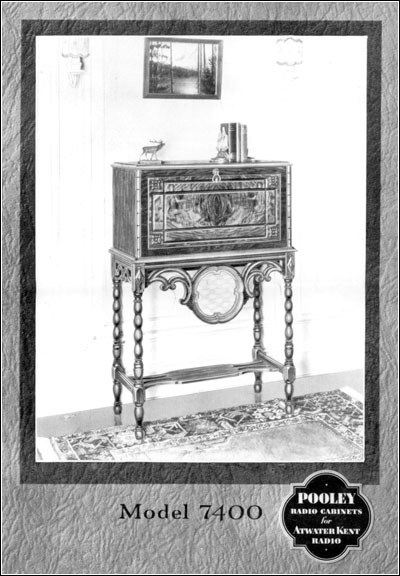Of Old Radios And Related Items--Published Monthly
The Pooley Furniture Company
and the Pooley RadioBY RICHARD ARNOLD
Web Edition
We associate cabinet styles with the name Pooley; however, the fact that Pooley also produced a radio is not common knowledge. Once again Richard Arnold delves into the history of an interesting company closely linked with radio. (Editor)
"Pooley radio cabinets and cabinet speakers are made by an organization which has devoted 43 years to the design and manufacture of the very highest grade furniture. Thousands of the finest homes, hotels and clubs in this country bear witness to the superlative art and craftsmanship of Pooley."
So says a 1926 Pooley sales pamphlet, restating the policy of a company that was to specialize in a line of work for which it had no peers.
James Barnum Pooley, who was born in Albany, Indiana, in 1855, founded the Pooley Furniture Company in 1892. He was joined in the business by two other family members, Edward Foster Pooley and Frank B. Pooley. Records from 1900 show that the company was located at 16th Street and Indiana Avenue, Philadelphia, Pennsylvania. However, Pooley also made furniture in New York, and was famous for the Pooley furniture in the Oak Room of the Plaza Hotel in New York City.
While making beautiful furniture, the company was also busy making cabinets for various talking machine companies, including the Edison Amberola. They also made cabinets to a major extent for Victor and Keen-O-Phone.
Figure 1. An Atwater Kent Model 10 breadboard in a Pooley cabinet similar to the Model 112-R-2 shown in Figure 3 (see print version). Unfortunately, there are tears in the grille cloth.Atwater Kent and Pooley Cabinets
Pooley started making radio cabinets in 1924. These were the first exclusively designed cabinets of the radio Industry, according to the company.
Of course, we all know that in the 1920s and early 1930s Pooley and Atwater Kent teamed up to make some very interesting radio cabinet designs. Figures 1 shows an Atwater Kent Model 10 in a Pooley cabinet from John Terrey's collection. Figure 2 (see print version) shows the decal on the drop-front of the cabinet, which is similar to the Model 1120-R-2, shown in Figure 3 (see print version).
I have a 1926 Pooley advertising pamphlet that has the following glowing endorsement by Mr. A. Atwater Kent: "The Pooley Radio Cabinet is approved for Atwater Kent Radio because of the design and quality of Pooley cabinet work and because of the tone qualities of the built-in Pooley floating horn. Both meet the standards we set and maintain for Atwater Kent Receivers and Speakers."
In fact, A. Atwater Kent gave Pooley a free hand in the design of his cabinets. No member of the Atwater Kent organization was allowed to recommend or even suggest any standards of design.
Figure 4. The Pooley factory as shown on the cover of the company instruction book, 4th edition.Those early cabinets gave an extra impetus to Atwater Kent Radio sales, and, in fact, to the entire radio industry. Radio suddenly blossomed into beautiful pieces of home furnishings. The company could claim that "The design, coloring and finish of Pooley radio cabinets and Pooley cabinet speakers are such that they can be set amidst the handsomest and costliest furniture and not suffer by comparison, and yet, they may be placed in rooms of the most simple furnishing and not be unduly noticeable."
Pooley also had trained radio engineers who worked for them and were responsible for the design and manufacture of the electrical equipment which was built into their cabinets. These professionals were also responsible for testing the Atwater Kent radios when they were received at the Pooley factory and then again prior to leaving the factory as a finished product.
Figure 5. Richard Arnold's Pooley Model 7400 radio cabinet.The fourth edition of the Pooley Instruction Booklet describes removing the Atwater Kent equipment from its carton and then removing the Pooley cabinet from its casing. Detailed assembly information is provided, including hookups for the batteries, antenna and ground.
One interesting item in the booklet is a "Special Notice." It says that the Pooley company had recently received reports from a few owners of Pooley radio cabinets that they were at times troubled with a howling noise when using their sets. Pooley investigated and found that this was happening to all makes of radio cabinets and that it was due to the modern radio tube's greater sensitivity. A long explanation of how to correct the problem followed.
Pooley's Growth
By 1928, the Pooley Company was located at 16001672 Indiana Avenue in Philadelphia. It was doing so much business that it had expanded to cover a whole city block, as shown in Figure 4.
On April 29, 1929, Pooley issued the Dealer Bulletin No. 6 stating that more than 600,000 Pooley radio cabinets had been made. It also states that "New 1929/30 Atwater Kent Radio cabinets by Pooley are about to be announced. The Pooley Company, with 47 years of experience in design and manufacture of fine furniture, again justifies your confidence by continuing the policies which have helped to build your business in the past."
Figure 6. Richard Arnold's Pooley radio cabinet with the drop-front down showing the American Bosch Model 28 installed.The American Bosch Model 28
Atwater Kent was apparently not the only company that used the Pooley cabinets to house its radios. My 1928 American Bosch Model 28, shown in Figures 5 and 6, is installed in a 1928 Pooley Cabinet Model 7400 radio desk. See my article on this set in the October 1994 A.R.C. Figure 7 shows the Pooley Model 7400 cabinet from an advertising broadside.
Pooley's description of this cabinet says that it is similar to the Model 7300, but it features a "stretcher" underneath the cabinet that provides accommodation for any Atwater Kent speaker. (I've always wondered what that thing was called.) When I found my radio, it did not have a speaker behind the stretcher, so I have installed an RCA 100A speaker, and it works fine.
The Pooley description of this cabinet continues: "Compartments for stationery, books, etc., make this model a complete and useful desk as well as an unusually handsome radio cabinet. Equipment includes inkwell and a large desk blotter."
The cabinet is made of carefully matched American walnut veneers, with satinwood and ebony inlays and Pooley's Standard American walnut duotone finish. All Pooley cabinets were finished in a rich, matte, lasting finish. Scratches would disappear when polished with a soft cloth.
The Pooley Model 7400 cabinet has its original finish. When new in 1928, the cabinet sold for $60 without the receiving set and speaker. As you can see, I am using it as the company intended it to be used, as a radio desk. The radio works well and so does the desk.
Pooley Radios
For the past few months, while gathering information for this article, I was very fortunate to come into contact with Mr. Thomas M. Pooley of Ringoes, New Jersey. Mr. Pooley may be a descendent of the Pooley side of the family that came to America from Cornwall, England, in the mid-1800s.
He has in his possession some very interesting Pooley Furniture Company and Pooley Radio information that he graciously shared with me. It is from this information and our e-mail exchanges that I have in great part been able to put together this article.
Figure 7. The Pooley Model 7400 from a broadside advertising the Pooley cabinets used with Atwater Kent radios.One of the pieces of information that Mr. Pooley sent to me is a complete 8-page Pooley Radio brochure from around 1930/31. In it, Pooley is advertising its new Pooley precision-built radio as "one of the most modern receiving sets made and rightly called, "The New Magic Voice of Radio."
The brochure also says that "Pooley radio comes to you through one fine dealer in each city. Direct from the factory. No distributor or jobber adds his costs and profits." In other words, Pooley controlled its own cabinet costs and production and claimed that selling only through high-class exclusive dealers assured "perfect service in the purchase of your set."
Pooley radios shown in this booklet ranged in price from $94.50 to $189. Representative radios are shown in Figures 8 (see print version), 9, and 10 (see print version) on the three pages following this page.
Pooley had contracted with Silver-Marshall, and it was the Silver-Marshall 8-tube, superheterodyne, screen grid radio that was used in the Pooley cabinets shown in this eight-page brochure. The radio was called the "Bearcat."
An article on the Silver-Marshall Company in the Furniture Manufacturer magazine from May 1929 reports that Silver-Marshall was opening a new, modern to the utmost detail, 100,000 square foot factory at 6435 West 65th St. in Chicago, Illinois. This new facility would be able to take care of the demand for the screen grid tube receivers, along with other chassis that were being made there, as it would have more than four times the manufacturing space than its present location on Jackson Boulevard in Chicago.
In Radio News for December 1929, there is a five-page advertisement on Silver-Marshall. Included is an ad from the I.A. Lund Corporation of Chicago, a cabinetmaker that was using the Silver-Marshall chassis in its cabinets also.
Some Pooley radios were made by Gilfillan Radio. Since Gilfillan was licensed by RCA, the company could and would on occasion contract with various nonlicensed companies, such as Troy, Ravenscroft, and Breting, to name a few, and maybe even Pooley.
These companies could design their circuits, order parts, put in a team of people at the Gilfillan plant to assemble the parts onto a chassis, test the radio and have an RCA license attached to the chassis. They could then ship the chassis plus speaker back to their plants for installation into a cabinet and ship to their customers.
Figure 9. The Pooley Model 20 Lowboy.However, with Pooley, it would seem more practical to simply order a chassis from another company such as Silver-Marshall or Gilfillan with an ongoing assembly line, have it tested, and then ship the chassis to the Pooley factory for retesting and installation in one of the Pooley radio cabinets.
Well, that just about does it. I have spent a lot of time doing research on the Pooley Company. I have come into contact with a lot of very interesting people, and I thank them for all of their help, advice and most of all the information that they so gladly shared with me.
The bottom line -- There is a Pooley radio.
Photo Credit: Dale Davenport, John Terrey.
Special thanks to Mr. Claude Chafin for his help and insight in answering some of my questions.
References:
Arnold, Richard. "The American Bosch Model 28," A.R.C., October 1994.
Patterson, Don. "Pooley Furniture Company," Radio Age, Feb-June 1992.
Paul, Floyd. Los Angeles Radio Manufacturers (The First Twenty Years). Glendale, CA: Floyd A. Paul, 1988.
Pooley, Thomas M. Pooley, family information. The New Pooley Radio Booklets, 1925 & 1926.
"Silver-Marshall to Manufacture Receivers," Furniture Manufacturers Magazine, May 1929.
Richard Arnold, a frequent contributor to A.R.C., has been collecting radios since 1985. His interest is primarily in cathedrals and 1920s battery sets, and his collection ranges from crystal sets to a 1928 American Bosch in a Pooley cabinet. His prize is the 1932 Jackson Bell Peter Pan featured in the June 1991 A.R.C.
| [Free Sample] [Books, etc., For Sale] [Subscribe to A.R.C./Renew] [Classified Ads] [Auction Prices] [Event Calendar] [Links] [Home] [Issue Archives] [Book Reviews] [Subscription Information] [A.R.C. FAQ] URL = http://www.antiqueradio.com/Nov07_Arnold_Pooley.html Copyright © 1996-2007 by John V. Terrey - For personal use only. Last revised: October 30, 2007. For Customer Assistance please contact ARC@antiqueradio.com or call (866) 371-0512 toll free
Antique Radio Classified |





